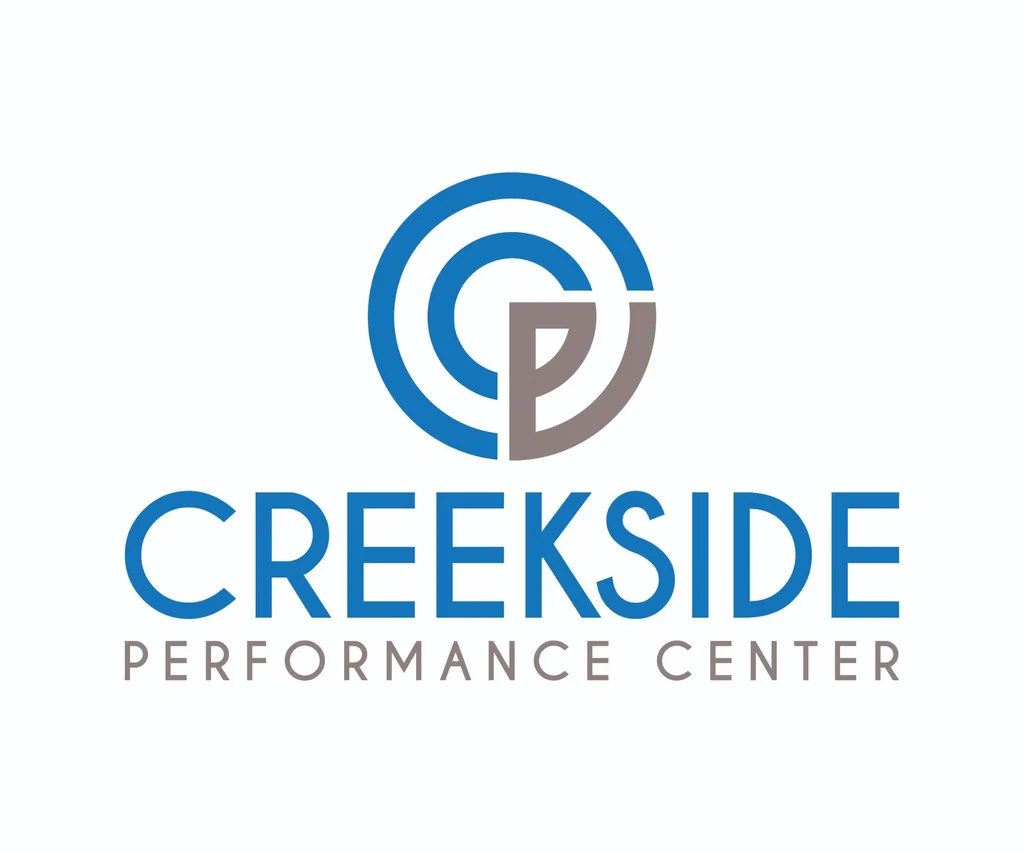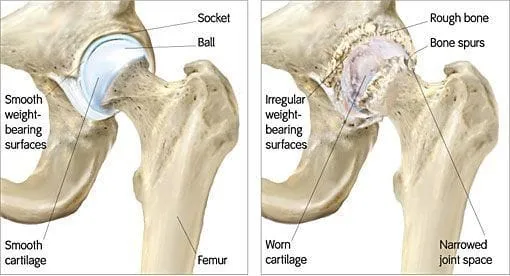What is hip osteoarthritis?
Hip osteoarthritis is the technical name for "hip arthritis" and differentiates this condition from other forms of arthritis, such as rheumatoid arthritis or psoriatic arthritis. Osteoarthritis, or "OA," occurs when the cartilage, which is the shock absorber for the hip has repetitive micro trauma. The micro trauma creates a response that causes the cartilage to swell, soften, and leads to surface damage of the cartilage. In the picture below, you can see on the left a normal hip joint. On the right, you can see the later stages of hip osteoarthritis: irregular surfaces, decreased joint spaces, broken down cartilage, and "bone spurs".
How common is hip osteoarthritis?
Estimates of the prevalence of hip OA vary from 3-33%.
What are the risk factors for hip osteoarthritis?
The likelihood of developing osteoarthritis increases with age, and the incidence appears to be slightly higher in males. There appears to be a genetic factor that may contribute. Other predisposing factors for hip OA include obesity, femoroacetabular impingement (FAI), and repetitive trauma, including occupations requiring prolonged standing or heavy physical exertion (1).
What are the symptoms of hip osteoarthritis?
An early presenting symptom of Hip OA is prolonged stiffness when waking up (less than 60 minutes) and following periods of inactivity (sitting). The patient will often complain of the inability to put their socks on, shave their legs, or climb stairs. Groin, front thigh, and buttock pain are common. The patient will often describe the location of their pain with the “C” sign, demonstrated by placing their index finger over the front of the hip, their thumb over the lateral hip region (2). Referral of pain below the knee is present in up to 47% of cases (3). The pain istarts dull and increases to sharp with standing. Clicking may develop as the condition progresses.
Do I need X-rays for hip osteoarthritis?
Radiographs are indicated for the assessment of hip pain in those over age 65, in cases of severe pain, or in those with a history of trauma, osteoporosis, cancer, corticosteroid use or alcohol abuse (12). Radiographic evidence of hip OA is common in seniors, although not all patients with radiographic degenerative changes will be symptomatic (1).
What are the treatment options for hip osteoarthritis?
Management of hip OA is directed at restoring motion and avoidance of aggravating factors. In recent years, several well-constructed studies have demonstrated that manipulation of the hip is a particularly effective treatment for hip OA (16-29, 30,36-39). A systematic review concluded that manual therapy and exercise therapy are beneficial for people with hip osteoarthritis in terms of reduced pain, improved physical function and improved quality of life (43). Several studies favor manipulation over exercise and some show that manipulation created the greatest and most beneficial gains in range of motion and pain reduction of all therapies studied (22-24, 26,41). Manipulation of contiguous regions, including lumbar, sacroiliac and lower extremity joints, is also appropriate.
What exercises can or should be done with hip OA?
Patients should consider increasing physical activity through swimming, cycling or walking on safe and flat surfaces.
Hip OA patients should be strongly encouraged to participate in a water-based exercise program ranging from formal PT hydrotherapy to classes at their local health club.
Exercises to improve ROM, increase strength and aerobic fitness is beneficial for hip OA patients (24,28,40).
Stretching of the muscles surrounding the hips may be beneficial.
Strengthening the glutes, quadriceps, hip external rotators and core musculature may be beneficial.
At Creekside Performance Center, we are highly trained to treat each of this condition. We are the only inter-disciplinary clinic providing services to Sheboygan, Sheboygan Falls, Plymouth, and Oostburg including chiropractic, manual therapy, myofascial release, ART (Active Release Technique), massage therapy, acupuncture, physiotherapy, rehabilitative exercise, nutritional counseling, personal training, and golf performance training under one roof. Utilizing these different services, we can help patients and clients reach the best outcomes and the best versions of themselves.
Evidence Based-Patient Centered-Outcome Focused
References
1. Lane, N. Osteoarthritis of the Hip. NEJM 357;14, Oct 4, 2007
2. Byrd J. Evaluation of the hip: history and physical examination. North American Journal Of Sports Physical Therapy: NAJSPT [serial online]. November 2007;2(4):231-240.
3. Khan, A.M., McLoughlin, E. Hip Osteoarthritis: Where is the Pain? Ann R Coll Surg Engl. 2004 March 86(2) 119-121
4. Bird P, Oakley S, ShnierR, Kirkham B. Prospective evaluation of magnetic resonance imaging and physical examination findings in patients with greater trochantericpain syndrome. Arthritis And Rheumatism [serial online]. September 2001;44(9):2138-2145.
5. Martin RL, IrrgangJJ, SekiyaJK. The diagnostic accuracy of a clinical examination in determining intra- articularhip pain for potential hip arthroscopy candidates. Arthroscopy. 2008;38:542-550.
6. SutliveT, Lopez H, Childs J, et al. Development of a clinical prediction rule for diagnosing hip osteoarthritis in individuals with unilateral hip pain. Journal Of Orthopaedic& Sports Physical Therapy [serial online]. September 2008;38(9):542-550.
7. SuenagaE, Noguchi Y, Iwamoto Y, et al. Relationship between the maximum flexion-internal rotation test and the torn acetabularlabrum of a dysplastic hip. Journal Of OrthopaedicScience: Official Journal Of TheJapanese OrthopaedicAssociation [serial online]. 2002;7(1):26-32.
8. Martin RL, IrrgangJJ, SekiyaJK. The diagnostic accuracy of a clinical examination in determining intra-articularhip pain for potential hip arthroscopy candidates. Arthroscopy. 2008;38:542-550.
9. Narvani A, TsiridisE, Kendall S, ChaudhuriR, Thomas P. A preliminary report on prevalence of acetabularlabrum tears in sports patients with groin pain. Knee Surgery, Sports Traumatology, Arthroscopy [serial online]. November 2003;11(6):403-408.
10. Lesher, J., Dreyfuss, P., Hager, N. Hip Joint Pain Referral Patterns: A Descriptive Study. Pain Medicine Vol. 9(1), 2008
11. DeAngelis, Nicola A. MD; Busconi, Brian D. MD Assessment and Differential Diagnosis of the Painful Hip. Clinical Orthopedics. Volume 406, January 2003, pp 11-18
12. Margo, K., Drezner, J., Motzkin, D. Evaluation and Management of Hip Pain: An Alogrithmic Approach Journal of Family Parctice Vol 52(8) August 2003
13. Stener-Victorin E, Kruse-Smidje C, Jung K. Comparison between electro-acupuncture and hydrotherapy, both in combination with patient education and patient education alone, on the symptomatic treatment of osteoarthritis of the hip. Clin J Pain 2004;20:179–85.
14. Cochrane T, Davey RC, Mattes Edwards SM. Randomised controlled trial of the cost-effectiveness of water based therapy for lower limb osteoarthritis. Health Tech Assess 2005;9:1–114.
15. Altman R, Alarcon G, Appelrouth D, Bloch D, Borenstein D, Brandt K, et al. The American College of Rheumatology criteria for the classification and reporting of osteoarthritis of the hip. Arthritis Rheum 1991;34:505–14.
16. Brantingham J, Williams A, Parkin-Smith G, Weston P, Wood T. A controlled, prospective pilot study into the possible effects of chiropractic manipulation in the treatment of osteoarthritis of the hip. Euro J Chiropr. 2003;51:149-166.
17. Hoskins W, McHardy A, Pollard H, Windsham R, Onley R. Chiropractic treatment of lower- extremity conditions: a literature review. J Manipulative Physiol Ther. Oct 2006;29(8):658- 671.
18. Brantingham JW, Bonnefin D, Perle SM, et al. Manipulative therapy for lower-extremity conditions: update of a literature review. J Manipulative Physiol Ther. Feb 2012;35(2):127- 66.(2):127-166.
19. MacDonald C, Whitman J, Cleland J, Smith M, Hoeksma H. Clinical outcomes following manual physical therapy and exercise for hip osteoarthritis: A case series. J Orthop Sports Phys Ther. Aug 2006;36(8):588-599.
20. Brantingham JW, Globe G, Cassa T, et al. A single-group pre-test post-test design using full kinetic chain manipulative therapy with rehabilitation in the treatment of 18 patients with hip osteoarthritis. J Manipulative Physiol Ther. July/August 2010;33(6):445-457.
21. Brantingham JW, Globe G, Cassa T, et al. A single-group pre-test post-test design using full kinetic chain manipulative therapy with rehabilitation in the treatment of 27 patients with hip osteoarthritis J Amer Chiropr Assoc. August 2010;47(6):8-26.
22. de Luca K, Pollard H, Brantingham J, Globe G, Cassa T. Chiropractic management of the kinetic chain for the treatment of hip osteoarthritis: an Australian case series. J Manipulative Physiol Ther. Jul-Aug 2010;33(6):474-479.
23. Brantingham JW, Parkin Smith, Cassa T, et al. Full kinetic chain manual and manipulative therapy plus exercise compared with targeted manual and manipulative therapy plus exercise for symptomatic osteoarthritis of the hip - a randomized controlled trial. Arch Phys Med Rehabil. 2012 93(2):259-267.
24. Abbott JH, Robertson MC, Chapple C, et al. Manual therapy, exercise therapy, or both, in addition to usual care, for osteoarthritis of the hip or knee: a randomized controlled trial. 1: clinical effectiveness. Osteoarthritis and Cartilage 2013;21(4):525-534.
25. Zhang W, Moskowitz R, Nuki G, et al. OARSI recommendations for the management of hip and knee osteoarthritis, Part II: OARSI evidence- based, expert consensus guidelines. Osteoarthritis and Cartilage. 2008;16:137-162.
26. Poulsen E, Hartvigsen J, Christensen HW, Roos EM, Vach W, Overgaard S. Patient education with or without manual therapy compared to a control group in patients with osteoarthritis of the hip. A proof-of-principle three-arm parallel group randomized clinical trial. Osteoarthritis Cartilage. Oct 2013;21(10):1494-1503.
27. French HP, Cusack T, Brennan A, et al. Exercise and manual physiotherapy arthritis research trial (EMPART) for osteoarthritis of the hip: a multicenter randomized controlled trial. Archives of Physical Medicine and Rehabilitation. Feb 2013;94(2):302-314.
28. Hochberg MC, Altman RD, April KT, et al. American College of Rheumatology 2012 recommendations for the use of nonpharmacologic and pharmacologic therapies in osteoarthritis of the hand, hip, and knee. Arthritis Care & Research. Apr 2012;64(4):465-474.
29. de Luca K, Pollard H, Brantingham J, Globe G, Cassa T. A randomized controlled trial of chiropractic management of the lower limb kinetic chain for the treatment of hip osteoarthritis: a study protocol J Chiro Med. 2011;10(2):86-92.
30. Official Disability Guidelines. The11th edition of the ODG for Treatment in Workers Compensation (updated 7/3/2013). Hip Osteoarthritis. www.worklossdatainstitute.verioiponly.com/.
31. Moseley JB, Jr., Wray NP, Kuykendall D, Willis K, Landon G. Arthroscopic treatment of osteoarthritis of the knee: a prospective, randomized, placebo-controlled trial. Results of a pilot study. The American Journal of Sports Medicine. Jan-Feb 1996;24(1):28-34.
32. Moseley J, O’Malley K, Petersen N, et al. A controlled trial of arthroscopic surgery for osteoarthritis of the knee. N Engl J Med. 2002;347(2):81- 88.
33. Nutton RW. Is arthroscopic surgery a beneficial treatment for knee osteoarthritis? Nat Clin Pract Rheumatol. Mar 2009;5(3):122-123.
34. Laupattarakasem W, Laopaiboon M, Laupattarakasem P, Sumananont C. Arthroscopic debridement for knee osteoarthritis. Cochrane Database Syst Rev. 2008(1):CD005118.
35. Kirkley A, Birmingham TB, Litchfield RB, et al. A randomized trial of arthroscopic surgery for osteoarthritis of the knee. N Engl J Med. Sep 11 2008;359(11):1097-1107.
36. Zhang W, Nuki G, Moskowitz RW, et al. OARSI recommendations for the management of hip and knee osteoarthritis: part III: Changes in evidence following systematic cumulative update of research published through January 2009. Osteoarthritis Cartilage. Apr 2010;18(4):476-499.
37. Pollard H, Ward G. A study of two stretching techniques for improving hip flexion range of motion. J of Manip & Physiol Ther. Sep 1997;20(7):443-447.
38. V aux P . Hip osteoarthritis: a chiropractic approach. Euro J Chiropr 1998;46(1):17-22.
39. Vaarbakken K, Ljunggren AE. Superior effect of forceful compared with standard traction mobilizations in hip disability? Adv Physiother. Sep 2007;9(3):117-128.
40. Fransen M, McConnell S, Hernandez-Molina G, Reichenbach S. Does land-based exercise reduce pain and disability associated with hip osteoarthritis? A meta-analysis of randomized controlled trials. Osteoarthritis Cartilage. May 2010;18(5):613-620.
41. Hoeksma HL, Dekker J, Ronday HK, et al. Comparison of manual therapy and exercise therapy in osteoarthritis of the hip: A randomized clinical trial. Arthritis Rheum. Oct 15 2004;51(5):722-729.
42. Official Disability Guidelines. The11th edition of the ODG for Treatment in Workers Compensation (updated 7/3/2013). General Information. Patricia Whelan, Publisher.
43. Sampath KK, Mani R, Miyamori T, Tumilty S. The effects of manual therapy or exercise therapy or both in people with hip osteoarthritis: a systematic review and metaanalysis.. Clin Rehabil. 2016 Dec;30(12):1141-1155.


